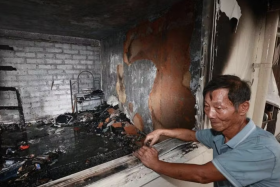Tie your way out of a tight spot
SCDF introduces Improvised First Aid Skills for use in event of terror attack
Belts, shoelaces and handkerchiefs.
Items one would normally take for granted can be the difference between life and death, especially with the threat of terrorism here.
The Singapore Civil Defence Force (SCDF) has introduced the Improvised First Aid Skills (IFAS) to educate members of the public on how to use everyday items to stop excessive bleeding during medical emergencies.
It is part of the SG Secure movement, which was announced in March, to prepare and train Singaporeans to protect themselves in the face of a terrorist attack.
Over the last few years, there has been an increase in the number of terror attacks worldwide, said SCDFchief medical officer Colonel (Dr) Ng Yih Yng.
He added that for casualties, bleeding is one of the main causes of death in a traumatic situation.

Col Ng, who has been in the force for four years, said: "If the bleeding is severe, the person can die in as short as three minutes. This is why first aid is important."
Responders who are caught in a terror attack should first find a safe place to hide before attempting to conduct IFAS in order to avoid drawing attention to themselves, he advised.
"The first thing you need to do is make sure you are in a safe place because you don't want to be in a position where you can also be a casualty," said Col Ng.
"Chaos after a terror attack can also make it difficult for emergency services to reach casualties. So, having someone nearby who can provide basic first aid will be very useful in an attack," he added.
IFAS comes in three steps - press, tie and tell:
Firstly, an absorbent such as a handkerchief, scarf or shirt can be pressed directly onto the wound to stem bleeding.
"Most of the time, direct pressure on the wound will stop bleeding," said Col Ng.
In the case of severe bleeding on the limbs, responders can use everyday items such as neckties, belts or lanyards to stem the excessive flow of blood by tying the affected area.
MORE TIME
"Once you tie tight enough, the bleeding will stop. That will give more time for SCDF officers to attend to the casualty," said Col Ng.
Where medical resources are stretched, Col Ng advised members of the public to alert emergency medical responders when someone is severely injured.
"By helping emergency services prioritise casualties who need immediate attention, more lives can be saved," he said.
When SCDF officers enter the scene, those who have been performing first aid should inform them of the injured's wound and the time it was attended to.
Col Ng said: "When it's a mass casualty situation and you have to attend to multiple severely injured people, it helps to record the time when a wound was tied."
"Items such as pens and lipsticks can be used to write the information on the forehead or uninjured upper parts of the limbs of the casualty."
He added that the three steps to conduct IFAS are not new ideas to stop bleeding.
"We can take the Boston Marathon bombings or the Paris attacks as good evidence that by doing basic first aid, many lives can be saved," Col Ng said. (See report on right.)
He also encouraged residents to attend their constituency's Emergency Preparedness Day to get trained on basic first aid.
Dr Ng said: "Some help is better than no help at all. Fifteen minutes of basic first aid training can go a long way."
Chaos after a terror attack can also make it difficult for emergency services to reach casualties. So, having someone nearby who can provide basic first aid will be very useful in an attack.
- SCDF chief medical officer Colonel (Dr) Ng Yih Yng
Three first aid steps
A person can die from excessive bleeding in three minutes, said Singapore Civil Defence Force (SCDF) chief medical officer Colonel (Dr) Ng Yih Yng.One can prevent the deterioration of injuries and increase the casualties' chances of survival by conducting first aid using the following steps:
PRESS:
Use commonly available absorbents such as a handkerchiefs or cloths to press directly on the wound to stop the bleeding. Hold the item in place with your hands or improvised bandages to maintain pressure.
TIE:
For severe wounds on the limb that are spurting blood, use items such as neckties, belts or shoelaces to tie above the wound to stem the bleeding.
TELL:
When the SCDF paramedics arrive, tell them about the casualty's injury and the time the wound was tied.

Get The New Paper on your phone with the free TNP app. Download from the Apple App Store or Google Play Store now



